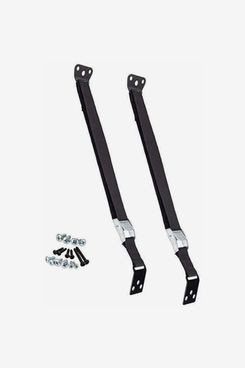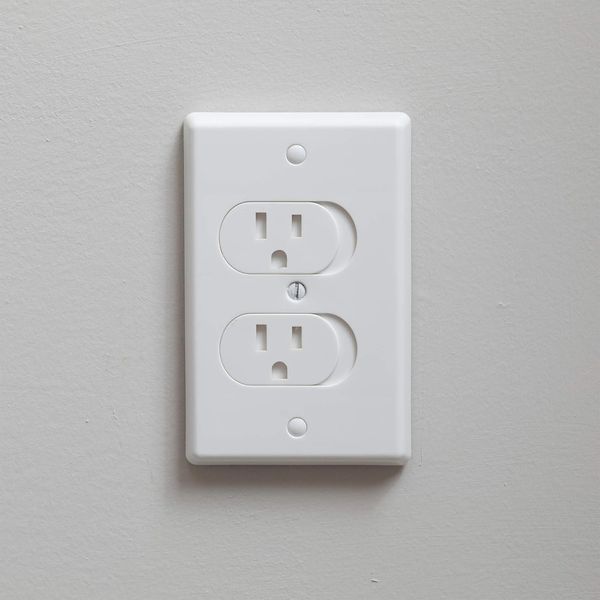
In this article
Once babies are mobile — whether they are scooting, crawling, or full-on walking — it gets harder to keep them safe. Babyproofing your home will help protect them from sharp corners, choking hazards, poisonous chemicals found in cleaning supplies, electrical outlets and cords, heavy furniture that can tip over, and dangerous falls. A lot of the time, all you have to do to babyproof a room is remove hazardous objects or place them out of reach. But for less adaptable items and situations, from a steep set of stairs to the toilet (a drowning risk!), there are a handful of truly essential products that will help ensure your home is as safe as possible.
There are thousands of babyproofing products available and still many situations where the perfect lock or strap doesn’t exist. So to help you avoid spending money on gadgets you don’t actually need, I talked to babyproofing experts about the best baby gates, cabinet and toilet locks, furniture anchors, corner protectors, outlet covers, and more. I specifically asked them to recommend products that are not only effective but easy enough for adults to use that they won’t be cast aside in a moment of frustration. I also asked for advice on vetting babyproofing products, generally: According to Holly Choi, a child-injury-prevention educator and co-founder of Safe Beginnings, there are many products marketed for babyproofing that aren’t actually child safe, like soft-foam corner protectors that kids can easily take a bite out of or too-small outlet covers that can become a choking hazard. Buying from a reputable brand that specializes in child safety is the best place to start. All babyproofing products should also meet safety standards established by ASTM International; formerly known as the American Society for Testing and Materials, the organization issues guidance for a wide range of consumer products, from toys to disposable face masks.
Updated October 21, 2024: Updated prices and checked stock for all products.
Baby gates
“I always say to people that what we’re trying to do is prevent a serious injury. We can’t realistically shield our children from every single bump and bruise,” says Choi. The first thing she recommends is putting hardware-mounted baby gates at the top and bottom of all stairs.
“If you’re placing something at the top of the stairs, it has to be hardware mounted, meaning it has to be screwed into something,” Choi says. This type of baby gate takes a bit more work to install — it’s most sturdy when screwed into a banister post or wall stud — but Choi considers it a nonnegotiable. While pressure-mounted baby gates might feel secure, Choi says it’s not that difficult for little kids to dislodge them and go flying down the stairs, adding that falling down the stairs with a baby gate can be even more dangerous than just falling down the stairs. Hardware-mounted gates also prevent a trip hazard because they don’t have the lip that runs along the bottom of a pressure-mounted gate. This hardware-mounted gate, from the brand QDOS, is a favorite of Choi’s because it meets ASTM standards for safety gates, is easy to use, and is nicer looking than a typical baby gate.
There are also angle-mount baby gates, which are similar to a standard hardware-mounted gate but allow you to install them at an angle. This is incredibly helpful if you have a post at the end of the stair banister that is not exactly parallel to the stud in the opposite wall. Choi recommends this one from KidCo.
If there isn’t a fall risk, and you’re just dividing two spaces on the same level, it’s fine to use a pressure-mounted baby gate — say, if you have a galley kitchen and you’re trying to keep curious kids away from the stove and out from underfoot. That said, no matter what type of gate you are getting, it needs to meet the ASTM standards for safety gates for babies. Choi points out that it can be difficult to differentiate between a baby gate and a pet gate, noting that baby gates are okay for pets but not vice versa. For example, some gates have a small door at the bottom that you can swing open for a cat to walk through and that leaves room for a child to be entrapped or strangled. Make sure to choose a brand with a focus on products for babies and children.
Furniture anchors
Furniture that isn’t properly anchored is one of the largest hazards that kids face at home and one that a lot of people don’t think about. It can be a pain to do, especially if you are renting and don’t want to put holes in the walls. But, as Choi puts it, “kids are fast, and it is truly shocking how little leverage it takes to pull down one of those really heavy dressers.” Her rule of thumb is that anything taller than it is deep and anything with two or more drawers needs anchoring. The one exception is cribs, because they are specifically designed not to tip.
To appropriately secure a piece of furniture, anchors have to be screwed into a stud. You shouldn’t use drywall anchors because they aren’t designed to hold the weight of a piece of furniture plus a child’s body weight. For this reason, both Choi and Carlos Sanchez, owner of Brooklyn Baby Gates, recommend furniture anchor straps that give you more flexibility to hit a stud no matter where it falls in relation to your furniture placement. These nylon straps were designed by a certified professional childproofer from the International Association for Child Safety. They can be tightened and loosened in case you need to move a dresser or your kid drops something behind it.
Smoke detectors and fire extinguishers
Smoke detectors and fire extinguishers aren’t typically considered babyproofing gear, but Sanchez says if you aren’t using them, you are neglecting two of the most important safeguards in your home. He recommends adding a smoke and carbon-monoxide detector combo to every room in your house. This one has a long-lasting, ten-year lithium battery, which makes the higher price point worth it. He also suggests always having a fire extinguisher at the ready and keeping it in a place where all adults and caregivers can find it.
Locks and latches
Because they are harder to open and concealed, magnetic cabinet locks have become the most popular choice for locking cabinets and drawers so that curious little fingers can’t get in. But they also require a key to use, which can slow you down when you’re cooking or cleaning, plus they can potentially get lost. Because of this, they are best used for the most dangerous stuff (cleaning supplies) or cabinets you don’t need to open all that often. I have this set of magnetic locks in my kitchen and bathroom cabinets. They were easy to install and can be used at the top of the cabinet door or along the side, which is also helpful if you have cabinets without an inner frame.
In high-traffic spots where magnetic locks are too tedious, finger-latch locks come in handy. You install them near the opening of a drawer or cabinet, and to operate them you just push down on the latch to release it. The only downside is that some kids will learn how to use them quicker than you think, so you have to avoid letting them see how you’re getting into everything.
For traveling to see grandparents or to an Airbnb, Choi recommends these sliding locks that loop around two door handles or knobs and then “zip” shut. “I’d keep those in a diaper bag so that if you end up at grandma’s place and she’s got no locks on her kitchen cabinets, you could just pop one on,” she says. I also use these locks at home on furniture that I want to protect from adhesive residue. Though they won’t work in every single scenario, they are a versatile option to have around.
It may seem far-fetched or easy to avoid, but Choi emphasizes that toilet drowning is a real risk and that it can happen in as little as 30 seconds. “Because children carry 30 percent of their body weight in their head until they are 1, and 25 percent of their body weight in their head until they are 2, they’re basically little bobbleheads,” she explains. “So if they fall into the toilet and don’t have their feet on the ground, they can’t leverage themselves out.” This is the lock I keep on my toilet whenever it’s not in use. I like that it has a decoy button to confuse curious toddlers.
Outlet covers
Covering electrical outlets is a more obvious part of babyproofing, but not all outlet covers are equal. You want something that doesn’t draw more attention to the outlet, is hard for children to remove, and isn’t so small as to pose a choking risk. Sanchez likes these self-closing covers that make it nearly impossible to forget to put the cover back and can’t be misplaced when the outlet is in use. They install in place of the regular wall plate and automatically close over the socket holes when something gets unplugged.
Corner guards
Corner guards can save you a trip to the emergency room during the learning-to-walk phase. If possible, Sanchez advises, choose furniture without sharp corners, especially on coffee tables, as they can pose significant risk to children’s eyes. He also suggests avoiding metal, glass, marble, and ceramic tabletops or placing furniture made from those materials in storage for a while until your baby masters moving without bumping into things. These corner protectors are large, so they aren’t a choking hazard, and made from a soft material that is safer than foam because kids can’t bite through it.
The Strategist is designed to surface useful, expert recommendations for things to buy across the vast e-commerce landscape. Every product is independently selected by our team of editors, whom you can read about here. We update links when possible, but note that deals can expire and all prices are subject to change.



















